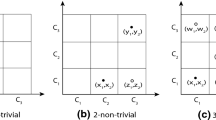Abstract
(1) This paper uses the following binary relations: > (is preferred to); ⩽ (is not preferred to); < (is less preferred than); ~ (is indifferent to). (2) Savage used primitive ⩾, postulated to be connected and transitive onA (the set of acts), to define the others: [x ~ y ⇔ (x ⩽ y and y ⩽ x)]; [y < x ⇔ notx ⩽ y]; [x > y ⇔ y < x]. Independently of the axioms, this definition implies that ⩽ and > are complementary relations onA: [x < y ⇔ notx > y]. (3) Pratt, Raiffa and Schlaifer used primitive ⩽, postulated to be transitive onL (the set of lotteries), to define the others with a different expression for <: [x < y ⇔ (x ⩽ y and noty ⩽ x)]. Thus, ⩽ and > are not necessarily complementary onL; since ⩽ is not postulated to be connected onL, but connected ⩽ is necessary and sufficient for such complementarity. Since the restriction of ⩽ to the subsetA ofL is connected, ⩽ and > are complementary onA. (4) Fishburn used primitive < onA to define the others with different expression for ~ and ⩽: [x ~ y ⇔ (notx < y and noty < x)]; [x ⩽ y ⇔ (x < y orx ~ y)]. His version of Savage's theory then assumed that < is asymmetric and negatively transitive onA. Thus, ⩽ and > are complementary, since asymmetric < is necessary and sufficient for such complementarity. (5) This analysis provides a new proof that the same list of elementary properties of binary relations onA applies to all three theories: ⩽ is connected, transitive, weakly connected, reflexive, and negatively transitive; while both < and > are asymmetric, negatively transitive, antisymmetric, irreflexive, and transitive; but only ~ is symmetric.
Similar content being viewed by others
Bibliography
R. H. Burros, ‘Axiomatic Analysis of Non-Transitivity of Preference and of Indif-ference’Theory and Decision 5 (1974), 185–204.
R. H. Burros, ‘Methodological Analysis of Imprecision in the Assessment of Personal Probabilities’ in W. Leinfellner and E. Köhler (eds),Developments in the Methodology of Social Science, D. Reidel Publishing Company, Dordrecht, Holland, 1974, pp. 337–362.
R. H. Burros, ‘Complementary Properties of Binary Relations’Theory and Decision 6 (1975), 177–183.
P. C. Fishburn,Utility Theory for Decision Making, John Wiley and Sons, Inc., New York, 1970.
J. Marschak and R. Radner,Economic Theory of Teams, New Haven, Conn., Yale University Press, 1972.
J. W. Pratt, H. Raiffa, and R. Schlaifer,Introduction to Statistical Decision Theory, McGraw-Hill Book Company, New York, 1965.
L. J. Savage,The Foundations of Statistics, Second Revised Edition, Dover Publications, Inc., New York, 1972.
P. Suppes,Introduction to Logic, Van Nostrand Rheinhold Company, New York, 1957.
Author information
Authors and Affiliations
Rights and permissions
About this article
Cite this article
Burros, R.H. Complementary relations in the theory of preference. Theor Decis 7, 181–190 (1976). https://doi.org/10.1007/BF02334314
Issue Date:
DOI: https://doi.org/10.1007/BF02334314



